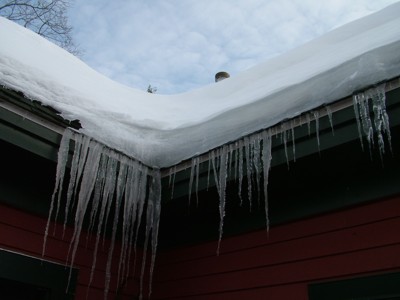Snow Roof

The snow is deep across the entire roof. As winter progresses, the snow compacts and gets heavier. PHOTO CREDIT: Tim Carter
DEAR TIM: I have a snow roof problem. There is, in my opinion, tons of snow on my roof. How can one calculate when the snow is reaching dangerous levels, and have to call in someone to clean it off? I use a snow roof rake, but am only able to get the lower end of my slanted roof. This roof snow removal is top on my list as I'm really worried about collapse. Many people had damage from last year's record snows. Elaine Jackson, Chicopee, MA
DEAR ELAINE: Snow on roofs is indeed a major issue. Snow is just frozen water, and liquid water weighs 62.42 pounds per cubic foot. The University of Arkansas Division of Agriculture Cooperative Extension Service published a great paper about snow loads in March of 2006. Dr. Jarl VonDevender and Doug Petty discussed in this white paper exactly what you are interested in knowing. They said:
"The water content of snow may range from 3% for very dry snow to 33% for a wet, heavy snow, to nearly 100% for ice. An inch of water depth weighs 5.2 lbs. per square foot. Thus, a roof designed to carry a snow load of 20 lbs. per horizontal square foot is expected to support nearly 12 inches of wet, heavy snow."
In all likelihood, your roof is probably designed for a snow load of 20 lbs. per horizontal square foot. But keep in mind that poor materials and poor building construction methods can contribute to a lower rating. Ice is the real danger as it weighs nearly the same as liquid water. A cubic foot of solid ice weighs 92% of what a cubic foot of liquid water. This means that your roof can only support a few inches of ice.
The snow on the roof needs to be removed immediately if you want to protect your home. Since you don't know if your builders and carpenters were building the best roof for snow, you have to assume they didn't. Without being an engineer or hiring one, you simply can't look and determine what roofs for snow look like. There are many variables not the least of which is the type of lumber and its grade that was used to frame the roof. Different lumber has vastly different strengths.
Depending upon the style of house you have, getting the snow from the roof might be difficult. Two story houses with low-slope roofs are the hardest. I've seen workers scale up these roofs wearing ice cleats and just shovel the snow to the ground. Steep pitched roofs tend to be the easiest to deal with as often these can be cleaned from the ground using snow roof rakes. I've used these tools to get lots of snow off my roof in a short amount of time.

The ice at the edge of this roof is nearly 6-inches thick. Just in this small section, there is hundreds of pounds of weight. PHOTO CREDIT: Tim Carter
Metal roofs and snow pose a different problem. Because the metal is slippery, snow can launch off these roofs without warning and cause serious injury or death to people who get buried by the avalanche. These roofs can be equipped with special accessories that break up the snow and ice into smaller pieces as it starts to slide, but the weight of the metal-roofing snow is still the same.
If you're unable to use a snow roof rake yourself, then hire an individual to do the job for you. Make sure this individual has Workman's Compensation insurance as well as general liability insurance. If he gets hurt while working, or the snow falls and damages something, you want to be sure you don't have to pay for these extra costs.
It was lost in the 2014 Treasure Hunt, but this column was mentioned in the February 23, 2014 AsktheBuilder Newsletter.
Column QA
5 Responses to Snow Roof